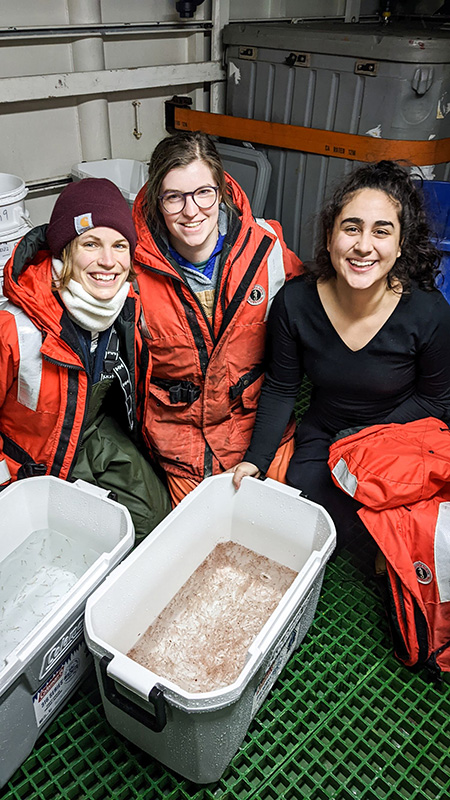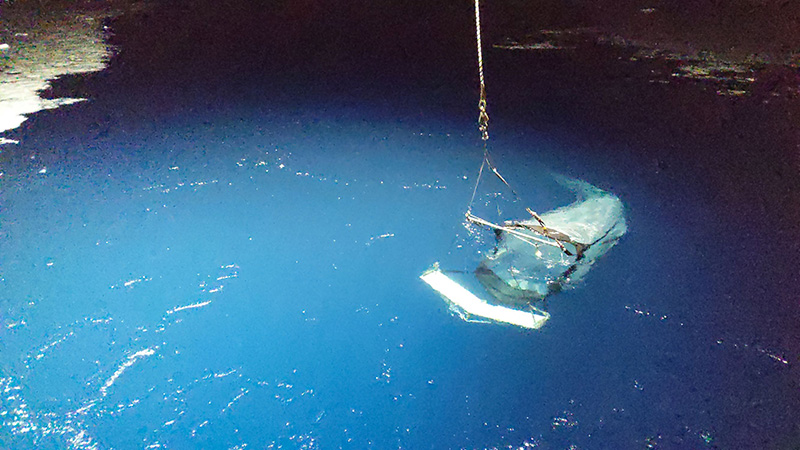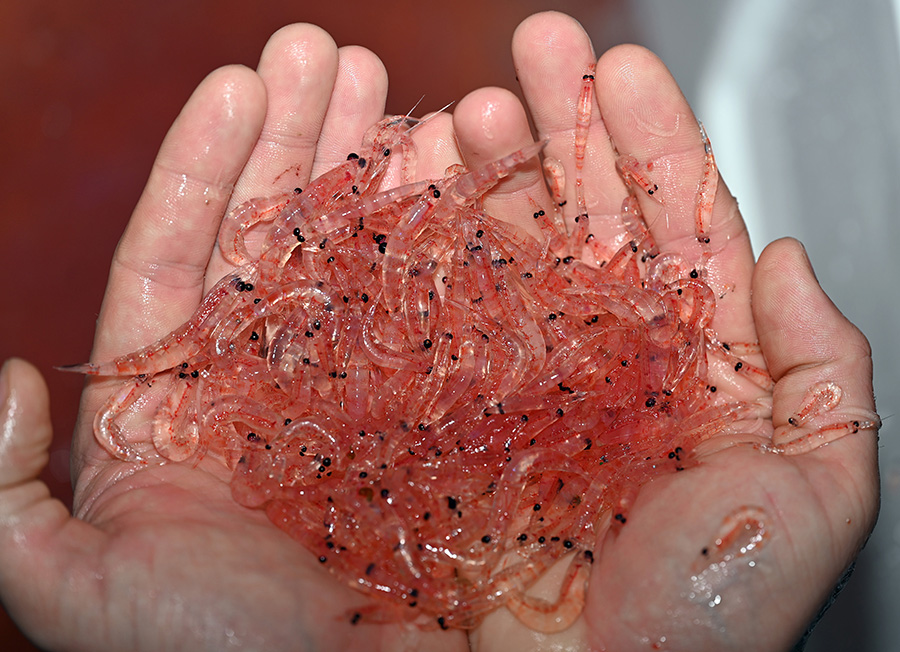How juvenile Antarctic krill survive when it's cold, dark and icyYoung krill adopt a mix of strategies to endure the long polar winterJanuary 17, 2023
A pair of recently-published companion studies help clarify how juvenile Antarctic krill survive the long winter season. The findings help researchers better understand the food web of the Southern Ocean and how this important animal species will adapt to a changing climate and increasing fishing pressure near the Western Antarctic Peninsula. 
Image Credit: Michael Tift.
Krill researchers Kirsten Steinke, Giulia Wood, and Andrea Nodal collect Antarctic krill during their winter cruise aboard the RVIB Nathaniel B. Palmer.
Krill are small swimming crustaceans resembling shrimp that travel in large schools called swarms. Though they are small in size (an adult is about the size of a human pinky), krill make up a huge portion of the Southern Ocean food web. Krill are one of the most abundant animal species on the planet and are the main food item eaten by baleen whales, seals, and penguins. They are also harvested for use as aquaculture feed, fish bait and health supplements. During the austral winter of 2019, our all-female research team set out on the Research Vessel Laurence M. Gould to catch swarms of juvenile krill. High winds, ice, and darkness make the Antarctic a harsh environment during the winter and animals like krill have certain adaptations to make it through the long, cold season. Krill mature and become adults around two to three years of age. In order to conserve energy during winter, adult krill survive off of lipid reserves and sexually regress when food availability is low, essentially reverting back to a juvenile state. Larvae, on the other hand, must feed throughout the winter in order to survive until spring. The differences in strategies between larvae and adults during winter is fairly well understood, but, until now, it has been unclear what strategies juvenile krill use to survive during this time. Our research team, led by Kim Bernard from Oregon State University, has been working for to discover the strategies juvenile krill at the Western Antarctic Peninsula use during the winter. In addition to field research at sea, our team also conducted long-term feeding experiments at NSF's Palmer Station on Anvers Island. 
Photo Credit: Kirsten Steinke.
Juvenile Antarctic krill caught during the winter time off the coast of the Western Antarctic Peninsula.
Over the course of the 2019 austral winter, we exposed juvenile Antarctic krill to four different food environment scenarios in a lab setting, supplementing them with various diets that represented the environmental conditions they may encounter in different regions of the Western Antarctic Peninsula. Each month, we assessed the physiology and body condition of a subset of juveniles and also the reproductive development of a subset of females. After many months living in the icy darkness of Antarctica followed by many more months analyzing data, we found something intriguing. Juveniles adopt a mix of strategies from both larval and adult krill during the winter. Like larvae, they will feed during the winter if food is available. But like adults, they also use their lipid reserves if food is scarce. This flexibility allowed the females in our study to begin the process of sexual maturation. Typically, krill won't begin to mature until spring when sunlight returns, and food is abundant. But we found that juvenile female krill initiated reproductive development during the winter by using a combination of lipid reserves and energy acquired through feeding. While this was an incredible discovery, we also found that it came at a cost. As females matured, their overall health and body condition declined. It takes a lot of energy for ovaries to grow, and we suspect the females' health declined in response to the amount of work it took to make this happen. 
Image Credit: Kirsten Steinke.
A trawl net surfaces after being deployed to collect Antarctic krill.
Our experiments showed that as lipid levels of the juveniles fell at the end of winter, they reverted back to earlier reproductive states and their overall health improved. The trade-off between reproductive development and health in juvenile krill is important, as early maturation may better prepare krill for the summer spawning season but may also leave them more vulnerable to harsh conditions in the environment. The findings also hinted at possible growth in juveniles during the winter, should they find sufficient food. While we couldn't explicitly test that theory in 2019, our team spent the 2022 austral winter in Antarctica, where we specifically investigated how food can drive winter growth in juvenile krill. Juveniles help structure krill populations, and studies like this one are critical in understanding how krill will adapt to pressures like climate change and expanding fisheries. Kirsten Steinke is a graduate student at Oregon State University. This research is supported by the National Science Foundation, which manages the U.S. Antarctic Program. NSF-funded research in this story: Kim Bernard, Oregon State University, award 1753101. |
"News about the USAP, the Ice, and the People"



For USAP Participants |
For The Public |
For Researchers and EducatorsContact UsU.S. National Science FoundationOffice of Polar Programs Geosciences Directorate 2415 Eisenhower Avenue, Suite W7100 Alexandria, VA 22314 Sign up for the NSF Office of Polar Programs newsletter and events. Feedback Form |


